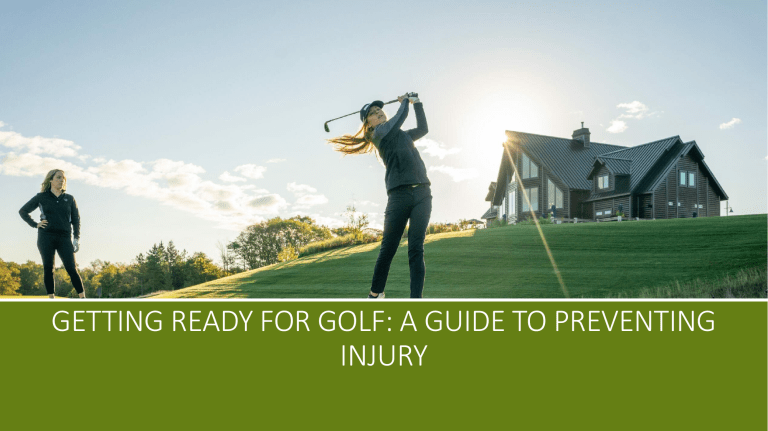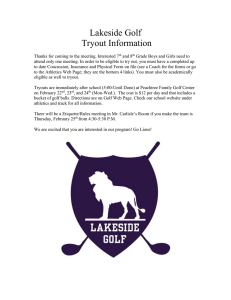
GETTING READY FOR GOLF: A GUIDE TO PREVENTING INJURY INTRODUCTION GOLF POPULARITY AND BENEFITS - Golf is a sport enjoyed by millions worldwide - Besides being a great way to socialize and enjoy the outdoors, golf offers various health benefits - It promotes cardiovascular health, improves strength and flexibility, and even challenges your strategic thinking skills IMPORTANCE OF INJURY PREVENTION IN GOLF - Like any sport, golf comes with some risk of injury. The repetitive nature of the golf swing can put strain on the body, particularly the lower back, shoulders, and elbows - Preventing these injuries isn't just crucial for maintaining your performance on the course; it's also key to your overall health and wellness ▪ This presentation will show you how to prepare your body for golf, minimize injury risk, and ensure you can enjoy this wonderful sport for years to come UNDERSTANDING GOLF AND ASSOCIATED RISKS THE PHYSICAL DEMANDS OF GOLF - Golf is a whole-body sport, engaging muscles from head to toe - Primary activities include swinging, walking, bending, and carrying - Involves explosive movements as well as endurance over several hours THE GOLF SWING - A DYNAMIC ACTION ▪ The golf swing: A complex, dynamic movement involving coordination and timing ▪ Major phases: Address, Backswing, Downswing, Impact, Follow-through ▪ Each phase engages different muscle groups and joints COMMON GOLF-RELATED INJURIES - Lower Back Pain: Resulting from repetitive twisting and bending - Golfer's Elbow: Caused by strain on the muscles and tendons of the forearm - Rotator Cuff Injury: Due to repetitive overhead movement and improper swing mechanics INJURY RISKS IN AMATEUR VS PROFESSIONAL GOLFERS - Amateur Golfers: Often suffer from injuries due to poor swing mechanics and lack of physical conditioning - Professional Golfers: Injuries often stem from overuse and repetitive strain on certain muscle groups THE IMPACT OF INJURIES IN GOLF - Injuries can significantly affect performance and enjoyment of the game - Chronic injuries may lead to long-term health issues - Proper training and preventive measures can help mitigate these risks THE ROLE OF KINESIOLOGY IN GOLF THE IMPACT OF INJURIES IN GOLF - Kinesiology is the scientific study of human movement. - In the context of golf, it plays a pivotal role in performance enhancement and injury prevention. UNDERSTANDING KINESIOLOGY - Kinesiology combines principles from anatomy, physiology, psychology, and biomechanics to understand human movement. - It is used to optimize performance, rehabilitate injuries, and prevent health problems associated with physical activity. - As kinesiologists, we use this knowledge to help golfers achieve their best performance while reducing their risk of injury. KINESIOLOGY IN GOLF PERFORMANCE - Applying principles of kinesiology to golf can enhance swing mechanics, increase distance, and improve accuracy. - It allows for personalized instruction based on individual golfer’s strength, flexibility, and biomechanics. - Proper body alignment and movement sequencing are key to a successful swing – kinesiology helps us understand these components better. KINESIOLOGY FOR INJURY PREVENTION - Understanding the body's movement and mechanics can help prevent injuries in golf. - Kinesiology principles can identify potential issues in a golfer’s swing that could lead to injury. - By improving body mechanics, we can reduce stress on joints and muscles commonly affected by golf. BIOMECHANICS OF GOLF - Golf involves complex movement patterns that require coordination, balance, strength, and flexibility. - Key movements include the stance, backswing, downswing, impact with the ball, and follow-through. - Biomechanical analysis of these movements helps optimize technique and reduce risk of injury. GOLF SPECIFIC FITNESS AND CONDITIONING IMPORTANCE OF PHYSICAL FITNESS IN GOLF - Just like any sport, physical fitness plays a critical role in golf. It affects not only your performance but also your risk of injury. Today, we're going to dive into the fitness components crucial for golfers THE FOUR PILLARS OF GOLF FITNESS - To improve your golf game and prevent injuries, we need to focus on four key areas of conditioning: flexibility, strength, endurance, and balance FLEXIBILITY FOR GOLFERS - Flexibility allows golfers to achieve a full range of motion, which is essential for a good golf swing. It also helps prevent injuries such as strains and sprains. Dynamic stretches and yoga are excellent for improving flexibility. - Suggested exercises: Shoulder and chest stretch, hip flexor stretch, hamstring stretch, trunk rotation. STRENGTH TRAINING FOR GOLFERS • Strength is needed for generating power in your swing and for maintaining good posture throughout the game. A good strength-training routine can significantly enhance your golf performance. • Suggested exercises: Squats, lunges, deadlifts, core strengthening exercises, wrist curls. ENDURANCE IN GOLF - Golf may seem like a relaxed sport, but a typical game can last several hours, with lots of walking and repeated swings. Building endurance through aerobic activities can improve your stamina and consistency throughout the game. - Suggested exercises: Brisk walking, cycling, swimming, and light jogging. BALANCE AND STABILITY IN GOLF - Balance is crucial in golf for maintaining the proper posture during the swing and for transferring energy effectively. Stability exercises can help you maintain control and prevent falls and slips on the course. - Suggested exercises: Single leg stands, yoga poses, bosu ball exercises, pilates. BUILDING YOUR GOLF FITNESS ROUTINE - A balanced golf fitness routine should incorporate exercises targeting flexibility, strength, endurance, and balance. - Regular practice, consistency, and progression are the keys to seeing improvements in your golf game and health. INJURY PREVENTION STRATEGIES INJURY PREVENTION STRATEGIES - Injury prevention is a crucial part of playing golf safely and effectively. In this section, we will cover proper golf techniques, the importance of warm-ups and cool-downs, nutrition for golfers, and the role of mental wellness in injury prevention. PROPER GOLF TECHNIQUES Incorrect golfing techniques can lead to a range of injuries. Let's talk about some key golf techniques. - The Swing: Maintain a smooth, rhythmic motion. Avoid overswinging. Coordinate movement of your entire body for power, not just your arms. - Posture: Keep your back straight, bend at the hips, and flex your knees slightly. This reduces stress on your lower back. - Grip: A too-tight grip can cause tension and elbow pain. Your grip should be firm but relaxed. IMPORTANCE OF WARM-UPS AND COOL-DOWNS Warm-ups and cool-downs are essential to prepare your body for the game and recover after it. - Warm-ups: Perform dynamic stretches and a few practice swings to increase your muscle temperature and flexibility. - Cool-downs: This helps to gradually lower your heart rate and relax your muscles. Practice static stretches targeting major muscle groups involved in golf (gluteal, hamstring, calf, shoulders, forearms) NUTRITIONAL ADVICE FOR GOLFERS Proper nutrition supports energy levels, focus, and recovery. Let's discuss some tips for golfers - Hydration: Drink water before, during, and after your game to maintain hydration. - Balanced Diet: Consume a balanced diet rich in lean proteins, complex carbohydrates, and healthy fats. - Snacking: Consider healthy snacks like nuts, fruits, or protein bars during long games. MENTAL WELLNESS AND ITS ROLE IN INJURY PREVENTION Mental wellness plays a significant role in injury prevention. Stress can cause muscle tension and distract you from proper technique. - Mindfulness: Be present in the moment, and be aware of your body and environment. - Relaxation Techniques: Practice techniques such as deep breathing and visualization to manage stress. - Positive Attitude: Embrace challenges, accept mistakes as learning opportunities, and maintain a positive outlook.


